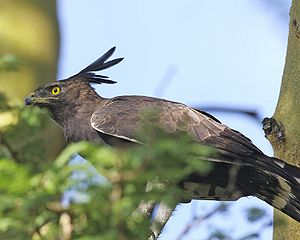Crested eagle
| Crested eagle | ||||||||||||
|---|---|---|---|---|---|---|---|---|---|---|---|---|

Crested eagle ( Lophaetus occipitalis ) |
||||||||||||
| Systematics | ||||||||||||
|
||||||||||||
| Scientific name | ||||||||||||
| Lophaetus occipitalis | ||||||||||||
| ( Daudin , 1800) |
The crested eagle ( Lophaetus occipitalis ) is a bird of prey from the hawk family . He lives in tropical Africa south of the Sahara . The species is unmistakable due to its predominantly black plumage and the striking bonnet.
description
Crested eagles are medium-sized birds of prey. They are about the size of a common buzzard , but have longer tails and legs, and are significantly heavier. Males weigh between 0.9 and 1.4 kg, females between 1.4 and 1.5 kg. The body length is 50 to 58 cm.
The plumage is predominantly black on the upper side. The bases of the outer and middle wings are white, the inner wings are white with dark banding. In flight, this white wing field contrasts very strongly with the otherwise black upper side. The tail is broadly contrasting light-dark banded. The underside of the body and the lower wing-coverts are also black, the wing crease is white. The hand and arm wings are banded white to light gray and dark on the underside. Overall, the bottom is very rich in contrast. As with all representatives of the Aquilinae, the legs are feathered down to the toes, this leg feathering is speckled white and dark brown.
The beak is dark gray, toes and wax skin are yellow. Both sexes wear a very conspicuous bonnet made of long, somewhat lobed feathers. The iris of the eyes is golden yellow to orange to reddish brown. Young birds differ only slightly from the colored birds. They are more dark brown than black, the under wing-coverts and the legs are mostly white with brown dashes and the tail is much narrower and less contrasty.
distribution and habitat
The crested eagle inhabits large parts of tropical Africa south of the Sahara. It colonizes a wide range of wooded habitats from the tropical rainforest to wet savannahs to gallery forests .
Systematics
The genus Lophaetus is monotypical, L. occipitalis is the only species. According to recent molecular genetic studies, this genus is probably not tenable, so the closest relatives of the crested eagle are lesser spotted eagles and spotted eagles . The species would therefore have to be placed in the genus Aquila ( real eagle ).
Hunting style and diet
The crested eagle is a typical hunter who spends hours on the lookout for prey on the ground in a tree, a pole or the like. The diet consists mainly of small, bottom-dwelling mammals and birds. In addition, small lizards , snakes , fish , insects and crabs and occasionally fruits are used.
Reproduction
The nest is made on trees. The clutch consists of 1–2 white, brown-spotted eggs and is mostly incubated by the female. The breeding season lasts about 42 days; the young eagles can fledge after 53–58 days.
Existence and endangerment
There is no reliable information about the world population , the IUCN gives 10,000–100,000 individuals as a very rough estimate. Despite regional population declines, the IUCN classifies the species as a whole as ![]() (= least concern - not endangered).
(= least concern - not endangered).
swell
Individual evidence
- ↑ HRL Lerner and DP Mindell: Phylogeny of eagles, Old World vultures and other Accipitridae based on nuclear and mitochondrial DNA . Molecular Phylogenetics and Evolution 37; 2005: pp. 327-346
- ↑ M. Wink and H. Sauer-Gürth: Phylogenetic Relationships in Diurnal Raptors based on nucleotide sequences of mitochondrial and nuclear marker genes . In: RD Chancellor and B.-U. Meyburg (eds): Raptors Worldwide . Berlin, Budapest, 2004: pp. 483–498
literature
- James Ferguson-Lees , David A. Christie: Raptors of the World. Christopher Helm, London 2001, ISBN 0-7136-8026-1 .
Web links
- Lophaetus occipital in the endangered Red List species the IUCN 2008. Posted by: BirdLife International, 2008. Accessed January 14 of 2009.
- Photo of an adult crested eagle
- Videos, photos and sound recordings on Lophaetus occipitalis in the Internet Bird Collection